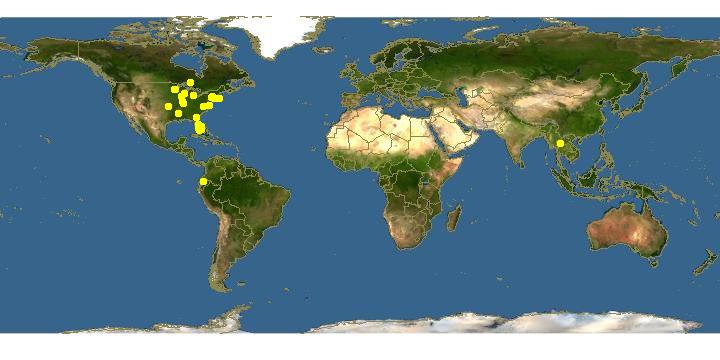
Habitat:
The Banded Mystery Snail is typically present in stationary or
slow-moving freshwater bodies because these are nutrient rich
environments. Viviparus georgianus prefers mud, sand, and
detritus-littered substrates along the edge or towards the bottom of
water systems, depending on the season. From spring to fall, the
Banded Mystery Snail spends most of its time towards the shore for
breeding purposes, and from fall to winter, it moves out to the
deeper benthic zones to prevent freezing and to find food. (Kipp and
Benson, 2011)
Viviparus
georgianus inhabits the Southeastern United States along with the
Mississippi and St. Lawrence River systems (Dillon, 2006). However,
it is native to Florida and Georgia and has invaded the Northeastern
states (Kipp and Benson, 2009). The Banded Mystery Snail, along with
other invasive gastropods, is being linked to ecosystem disruption
in nonnative habitats. Large numbers of water fowl deaths in the
Upper Midwest are occurring due to infections by trematode worms.
Viviparus georgianus is being linked to the infection because it is
believed to be an intermediate host to this parasitic worm. (Dillon,
2006)

Despite this
traumatic environmental impact, Viviparus georgianus fulfills an
important ecological niche. The Banded Mystery Snail has a large
variety of feeding methods. It is a grazer and filter-feeder that
consumes filamentous algae, diatoms, and suspended organic material
(Jokinen et. al, 1982) It will occasionally eat fish eggs and
decaying matter (Jokinen et. al, 1982). During the spring and
summer, it finds protection under macrophytes, which are water
plants that can be either floating or submerged (Kipp and Benson,
2010). Other organisms that coexist with this snail include mussels
and clams that filter-feed and compete for suspended organic material (Martin Kohl).
Viviparus georgianus provides food for organisms such as turtles,
fish, birds, and crayfish (Jokinen et. al, 1982). In addition, it is
a host for parasitic organisms such as annelid worms, protozoans,
and trematode larvae (Kipp and Benson, 2011).